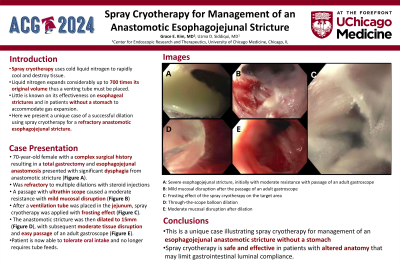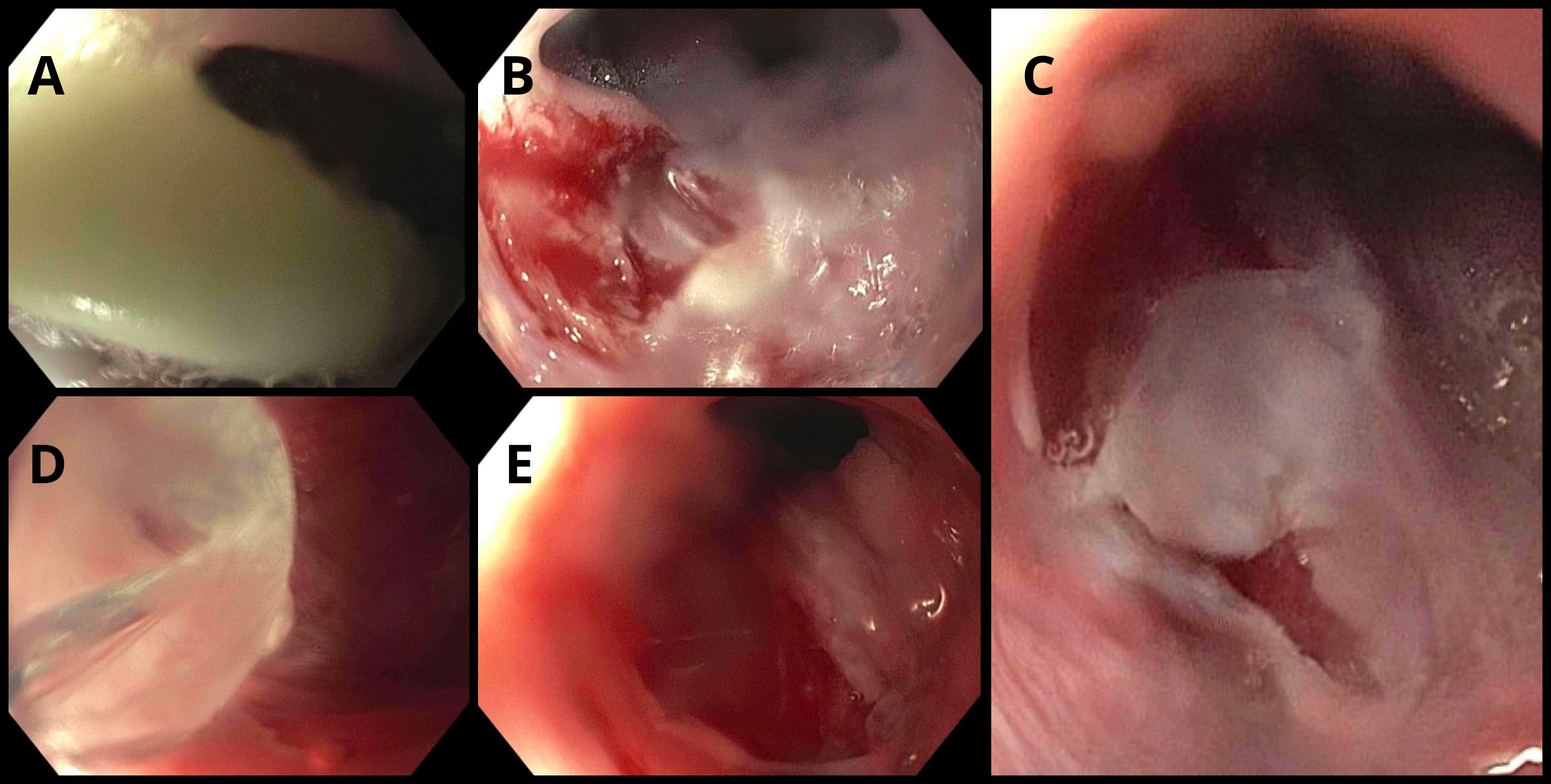Monday Poster Session
Category: Endoscopy Video Forum
P2172 - Spray Cryotherapy for Management of an Anastomotic Esophagojejunal Stricture
Monday, October 28, 2024
10:30 AM - 4:00 PM ET
Location: Exhibit Hall E

Has Audio
- GK
Grace E. Kim, MD
Center for Endoscopic Research and Therapeutics (CERT), University of Chicago
Chicago, IL
Presenting Author(s)
Grace E. Kim, MD, Uzma D. Siddiqui, MD
Center for Endoscopic Research and Therapeutics (CERT), University of Chicago, Chicago, IL
Introduction: Spray cryotherapy uses cold liquid nitrogen to rapidly cool and destruct tissue. Because liquid nitrogen expands considerably to 700 times its original volume as it evaporates, a venting tube must be placed to quickly remove the nitrogen gas in the stomach. Traditionally, cryotherapy is used for Barrett’s esophagus and esophageal malignancy, but little is known on its effectiveness on esophageal strictures. Here we present a unique case of a successful dilation using spray cryotherapy for a refractory anastomotic esophagojejunal stricture.
Case Description/Methods: 70-year-old woman with breast cancer and chemoradiation had a complex surgical history of fundoplication with intraoperative complications resulting in a total gastrectomy and esophagojejunal anastomosis. This was complicated by an anastomotic stricture causing significant dysphagia (Figure 1A). A standard upper endoscope was never able to be traversed in the past despite five previous dilations and steroid injections, and the patient required a nasojejunal tube for nutrition. Due to the refractory nature of the stricture, the decision was made to use spray cryotherapy to assist with dilation. Initially, an ultrathin gastroscope was passed with a moderate resistance at the anastomotic site 18cm from the incisors. There was a mild mucosal disruption visualized (Figure 1B). After a ventilation tube was placed via guidewire in the jejunum, liquid nitrogen cryogen was applied for 10 seconds with the appearance of a frosting effect across the target zone for 3 cycles (Figure 1C). Then a through-the-scope balloon dilator was inserted and the anastomotic stricture was dilated to 15mm over a guidewire and under fluoroscopic guidance (Figure 1D), with subsequent moderate tissue disruption and complete resolution of luminal narrowing with easy passage of an adult gastroscope (Figure 1E). Patient is now able to tolerate oral intake and no longer requires tube feeds.
Discussion: Spray cryotherapy with dilation has previously been reported in case series as an effective therapeutic option for esophageal strictures, but mainly in patients with an intact stomach to accommodate for gaseous distension. To our knowledge, this is the first report of using a spray cryotherapy for management of an esophagojejunal anastomotic stricture without a stomach to assist with the rapid volume expansion. This case illustrates that spray cryotherapy is safe and effective in patients with altered anatomy that may limit gastrointestinal luminal compliance.

Disclosures:
Grace E. Kim, MD, Uzma D. Siddiqui, MD. P2172 - Spray Cryotherapy for Management of an Anastomotic Esophagojejunal Stricture, ACG 2024 Annual Scientific Meeting Abstracts. Philadelphia, PA: American College of Gastroenterology.
Center for Endoscopic Research and Therapeutics (CERT), University of Chicago, Chicago, IL
Introduction: Spray cryotherapy uses cold liquid nitrogen to rapidly cool and destruct tissue. Because liquid nitrogen expands considerably to 700 times its original volume as it evaporates, a venting tube must be placed to quickly remove the nitrogen gas in the stomach. Traditionally, cryotherapy is used for Barrett’s esophagus and esophageal malignancy, but little is known on its effectiveness on esophageal strictures. Here we present a unique case of a successful dilation using spray cryotherapy for a refractory anastomotic esophagojejunal stricture.
Case Description/Methods: 70-year-old woman with breast cancer and chemoradiation had a complex surgical history of fundoplication with intraoperative complications resulting in a total gastrectomy and esophagojejunal anastomosis. This was complicated by an anastomotic stricture causing significant dysphagia (Figure 1A). A standard upper endoscope was never able to be traversed in the past despite five previous dilations and steroid injections, and the patient required a nasojejunal tube for nutrition. Due to the refractory nature of the stricture, the decision was made to use spray cryotherapy to assist with dilation. Initially, an ultrathin gastroscope was passed with a moderate resistance at the anastomotic site 18cm from the incisors. There was a mild mucosal disruption visualized (Figure 1B). After a ventilation tube was placed via guidewire in the jejunum, liquid nitrogen cryogen was applied for 10 seconds with the appearance of a frosting effect across the target zone for 3 cycles (Figure 1C). Then a through-the-scope balloon dilator was inserted and the anastomotic stricture was dilated to 15mm over a guidewire and under fluoroscopic guidance (Figure 1D), with subsequent moderate tissue disruption and complete resolution of luminal narrowing with easy passage of an adult gastroscope (Figure 1E). Patient is now able to tolerate oral intake and no longer requires tube feeds.
Discussion: Spray cryotherapy with dilation has previously been reported in case series as an effective therapeutic option for esophageal strictures, but mainly in patients with an intact stomach to accommodate for gaseous distension. To our knowledge, this is the first report of using a spray cryotherapy for management of an esophagojejunal anastomotic stricture without a stomach to assist with the rapid volume expansion. This case illustrates that spray cryotherapy is safe and effective in patients with altered anatomy that may limit gastrointestinal luminal compliance.

Figure: 1A: Severe esophagojejunal stricture, initially with moderate resistance with passage of an adult gastroscope
1B: Mild mucosal disruption after the passage of an adult gastroscope
1C: Frosting effect of the spray cryotherapy on the target area
1D: Through-the-scope balloon dilation
1E: Moderate mucosal disruption after dilation
1B: Mild mucosal disruption after the passage of an adult gastroscope
1C: Frosting effect of the spray cryotherapy on the target area
1D: Through-the-scope balloon dilation
1E: Moderate mucosal disruption after dilation
Disclosures:
Grace Kim indicated no relevant financial relationships.
Uzma Siddiqui indicated no relevant financial relationships.
Grace E. Kim, MD, Uzma D. Siddiqui, MD. P2172 - Spray Cryotherapy for Management of an Anastomotic Esophagojejunal Stricture, ACG 2024 Annual Scientific Meeting Abstracts. Philadelphia, PA: American College of Gastroenterology.
